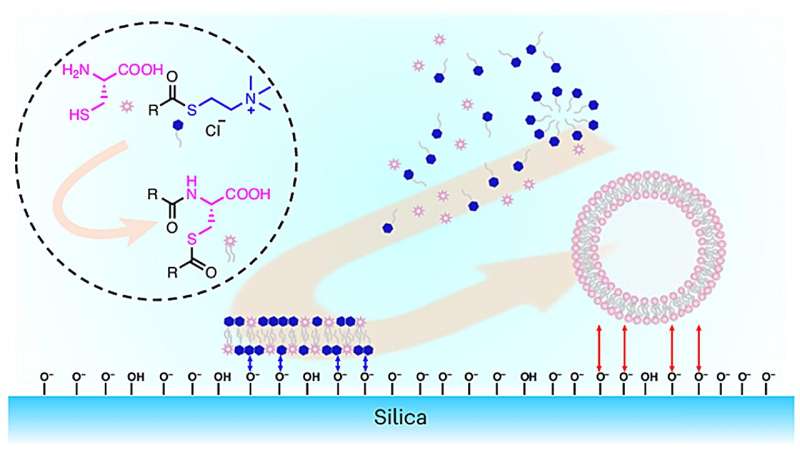A team of biochemists at the University of California, San Diego, working with a group of biochemical engineers from the University of California, Los Angeles, has found that the development of short lipids might have led to the development of the first cell membranes on early Earth.
In their study published in the journal Nature Chemistry, the group combined cysteine with chemical relatives of fatty acids to form lipids with two tails, finding clues about the origins of life on Earth.
The research team reasoned that for cells to get their start on early Earth, some form of cell boundary must have formed first to protect cell contents from the environment. Noting that modern cell membranes are all made of lipids, the researchers wondered if the first cell membranes might have been made of lipids as well—and if that was the case, how they might have developed from simple molecules.
They also noted that modern cell membranes are complex and generally long chained. Suspecting that early-life molecules would have had simpler membranes, they wondered if they might have been made of short fatty acids.
To find out, the team started with cysteine, an amino acid that they had previously identified as likely prevalent during the earliest days of the planet, serving as a glue of sorts, holding precursor molecules together.
They combined the amino acid with short fatty acids with eight carbon atoms. During combination, the molecules reacted, forming a lipid—one with two tails. They noted that some of them also self-formed into spheres with membranes, which the team dubbed protocells. The spheres lacked any of the compounds found in living cells, of course, but did appear to be capable of serving as a sort of staging ground.
The researchers also saw that the protocell membranes were aligned in a double layer and the spheres showed signs of being able to corral other molecules inside of them, allowing for the admission of other components for the development of life. Their protocells were robust enough to survive mixing with the magnesium and calcium ions that would most likely have been plentiful on early Earth.
According to the researchers, the work shows a possible means for the development of cell membranes on early Earth, making the path toward the development of life possible.
More information:
Christy J. Cho et al, Protocells by spontaneous reaction of cysteine with short-chain thioesters, Nature Chemistry (2024). DOI: 10.1038/s41557-024-01666-y
© 2024 Science X Network
Citation:
Biochemists create protocells to explore how lipids may have led to first cell membranes (2024, November 3)
retrieved 3 November 2024
from https://phys.org/news/2024-10-biochemists-protocells-explore-lipids-cell.html
This document is subject to copyright. Apart from any fair dealing for the purpose of private study or research, no
part may be reproduced without the written permission. The content is provided for information purposes only.

